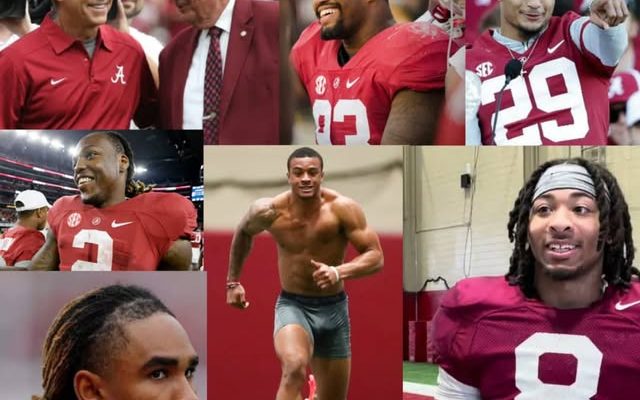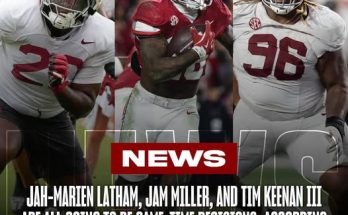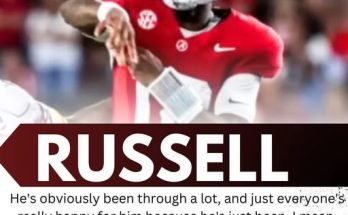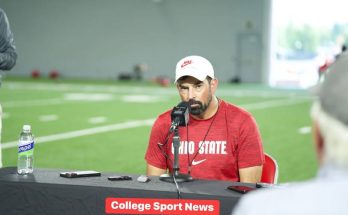The air in Tuscaloosa is electric again. Crimson jerseys glint in the sun, the sound of cleats slicing into turf echoes from Bryant-Denny Stadium, and the echoes of past glories no longer feel distant—they’re alive, reborn in motion. In an unprecedented and historic move, the Alabama Crimson Tide has welcomed back eight of its most iconic figures, a blend of coaching masterminds and gridiron warriors, to reinvigorate the legacy of the program that has long set the standard for college football excellence.
Among the returning legends are Nick Saban, Gene Stallings, Jalen Hurts, Derrick Henry, and Patrick Surtain II. Each name carries a weight that resonates far beyond Alabama. Their return—whether in mentorship, strategic consulting, or motivational leadership—signals something far more powerful than a tactical shift. It’s a cultural renaissance, a call to arms for a new generation of Crimson Tide athletes to reconnect with the roots of what made Alabama the most dominant program in modern college football history.
Nick Saban’s return is perhaps the most seismic of all. After stepping down from head coaching duties following a historic tenure that brought six national championships to Tuscaloosa, many believed his days on the sidelines were over. Yet, time away from the game did little to dull his edge. Rather than assume a traditional coaching role, Saban has taken on a hybrid position: master strategist, culture architect, and leadership advisor. His role is to instill the “Process”—his famed philosophy of discipline, preparation, and execution—back into every fiber of the program.
From the moment Saban walked into the athletic facility, the atmosphere shifted. “He’s not here to coach the playbook,” one assistant said. “He’s here to coach the soul of this team.” Practices have been sharper. Film sessions more intense. The expectations, once taken for granted, have been recast in bold relief. For current players, the message is clear: if Saban is back in the building, complacency is no longer welcome.
But the resurrection of the Tide’s legacy isn’t resting solely on Saban’s shoulders. The return of Gene Stallings has added a second layer of championship pedigree. Stallings, who coached Alabama to the 1992 national championship, brings a sage presence to the operation. While physically less involved than during his coaching heyday, Stallings has become a spiritual guide to the staff, sharing lessons not only from the playbook but from life. “Coach Stallings reminds us why we play this game in the first place,” said one team captain. “His words don’t just prepare you for Saturdays. They prepare you for everything after.”
In this new era of Alabama football, the old guard is not returning merely to relive the glory days—they’re here to mentor the future. And no one embodies the bridge between past and present more fully than Jalen Hurts. The former Alabama quarterback, now an NFL Pro Bowl star and MVP candidate, returned this offseason not to reclaim past honors but to forge new connections.
Hurts, who endured both triumph and heartbreak during his time at Alabama—most notably being benched during the 2018 national championship game before returning to lead the team later that season—represents the emotional resilience and loyalty that define the Crimson Tide ethos. His presence at practices, team meetings, and leadership seminars has already made a profound impact.
“He tells us what it’s like to lead when it’s hard,” said sophomore quarterback Caleb Jefferson. “What it’s like to sit, wait, and still rise. That’s a story we all need to hear.” Hurts leads on and off the field, sharing insights into preparation, professionalism, and how to carry oneself with dignity in both victory and defeat. For a young team looking to rediscover its championship mettle, Hurts is more than a mentor—he’s a mirror reflecting what’s possible.
Then there’s Derrick Henry, the human freight train who bulldozed his way to a Heisman Trophy in 2015 and rewrote Alabama’s rushing records. Henry’s return has lit a fire under the Tide’s current stable of running backs. With his chiseled frame still NFL-ready and his voice a deep, commanding force, Henry has taken on the role of physical performance mentor. He works directly with strength and conditioning staff and runs specialized drills with running backs, teaching them the patience, vision, and punishing style that made him a legend.
When asked why he returned, Henry’s answer was simple: “Because I owe everything to this place. And now it’s time to give it back.”
Watching Henry sprint down the sideline during training sessions, it’s easy to forget he’s no longer a college player. For many on the team, he’s become the living embodiment of the standard they’re chasing—a powerful, living memory reminding them that greatness is possible with enough sweat, sacrifice, and belief.
Patrick Surtain II, one of Alabama’s most technically gifted defensive backs in recent memory, adds a more cerebral element to the reunion. A shutdown corner now plying his trade at an elite level in the NFL, Surtain’s contribution is more tactical. He’s returned to help elevate Alabama’s secondary—once a crown jewel of the program, now in need of refinement.
Surtain has been working closely with the team’s young defensive backs on footwork, anticipation, and film study. His attention to detail, combined with his calm demeanor, has quickly made him a favorite among the defense. “He teaches like a pro, but he speaks like a brother,” said freshman DB Malik Jackson. “It’s not about fear with him. It’s about confidence. He makes you believe you can guard anybody.”
This return of elite alumni is more than symbolic. It’s strategic. Each legend was handpicked not just for their name recognition but for what they could tangibly offer. Alabama’s administration, with the blessing of its new head coach and athletic department, created specialized roles tailored to each individual’s strengths—consultant, mentor, performance coach, leadership guide. It’s an all-hands-on-deck initiative to pull Alabama back to the mountaintop, and the results are already showing in offseason workouts and scrimmages.
Beyond these five headline names, three more former legends have quietly returned as part of this new initiative—players and coaches whose presence might not dominate headlines but who are deeply embedded in the DNA of Alabama’s historic success. They help run operations behind the scenes, scout talent, offer one-on-one development, and even work with alumni relations to ensure continuity between past and present.
The “Dynamic Substitutions” project, as insiders have come to call it, marks a revolution in how elite college football programs can operate. While other schools rely heavily on analytics, NIL deals, and the transfer portal to gain an edge, Alabama is betting on something deeper: tradition, mentorship, and the transference of legacy. The belief is that when young players train side-by-side with legends, greatness becomes less of a myth and more of an expectation.
Skeptics initially questioned whether these returning stars could co-exist within a modern football infrastructure, especially one brimming with fresh talent and evolving philosophies. But those concerns have quickly faded. The camaraderie between the old guard and the new blood has created a hybrid culture—one that respects tradition but innovates within it. Players today are learning the art of adaptation from the very men who built the program’s foundation.
Of course, this kind of cultural overhaul isn’t without pressure. With legends walking the halls and setting the tone, the expectations are sky-high. But that’s exactly the point. Alabama doesn’t shy away from pressure—it thrives on it. This new generation is being asked to carry the same torch that lit the paths of Saban’s dynasties and Stallings’ champions. And with the direct support of the men who once hoisted that torch themselves, there’s reason to believe they can.
As the new season looms, Tuscaloosa feels like a time machine fused with a launchpad. The past is no longer something remembered—it’s something active, moving, mentoring, leading. The Alabama Crimson Tide hasn’t just reloaded. It has reignited.
In the stands, fans chant familiar names. On the practice field, legends whisper wisdom into young ears. And behind closed doors, the playbook of legacy continues to be written—not in ink, but in blood, sweat, and the unshakable bonds of crimson pride.
Alabama isn’t just chasing another title. It’s building a dynasty powered by its own past. And with Saban, Stallings, Hurts, Henry, Surtain II, and others back in the fold, one truth has never been more clear: The Tide is rising again.



